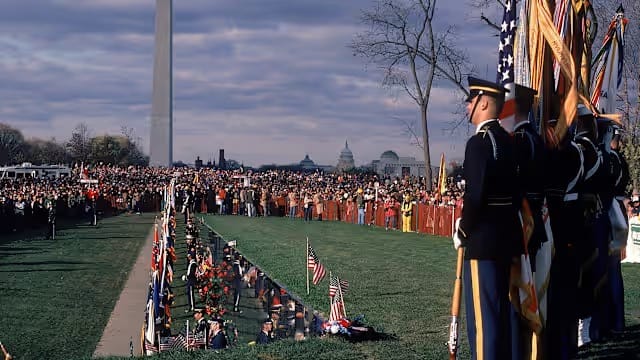Top 5 US news stories
November 13 2025

Government Reopens After House Narrowly Passes Spending Deal
Democrats Erupt in Anger Over Shutdown Compromise
States Miss Deadline to Agree on Colorado River Water Cuts
‘Phantom’ Data Centers Inflate Power Demand Forecasts
Brutal Fight for Pokrovsk Exposes Putin’s Imperial Aims
1. Government Reopens After House Narrowly Passes Spending Deal
The federal government began reopening Wednesday night after President Trump signed into law a spending package that narrowly passed the House, ending the longest shutdown in the nation’s history. “With my signature, the federal government will now resume normal operations,” Mr. Trump said as he signed the legislation alongside Republican House leadership and business executives. Earlier, the House voted 222 to 209 on Day 43 of the shutdown and days after eight senators in the Democratic caucus broke their own party’s blockade and joined Republicans in allowing the spending measure to move forward, prompting a bitter backlash in their ranks. It was the first time the House had held a vote in nearly two months, after an extended recess during the shutdown. Some programs like food stamps, or the Supplemental Nutrition Assistance Program, could be restored within hours, while other effects could take longer to unravel.
NYT
2. Democrats Erupt in Anger Over Shutdown Compromise
The bitter rebukes came from every corner of the Democratic Party. Moderate House members, progressive senators, self-described insurgents and establishment candidates alike all expressed the same, vehement opposition to the deal that eight senators in the Democratic caucus struck to end the nation’s longest government shutdown. They denounced a compromise that the Senate passed on Monday, saying it had done nothing to realize their party’s main demand in the 41-day shutdown fight: the extension of health care subsidies set to expire at the end of the year. “A deal that doesn’t reduce health care costs is a betrayal of millions of Americans counting on Democrats to fight for them,” Representative Greg Casar of Texas, the chairman of the House Progressive Caucus, said.
NYT
3. States Miss Deadline to Agree on Colorado River Water Cuts
The seven states that rely on the Colorado River for drinking water missed a Tuesday deadline to agree on reduced shares as the river’s flow continues to decline dramatically. But the states and the U.S. Bureau of Reclamation, which manages the river and its reservoirs, said that negotiations would continue, citing “extraordinary pressure on this critical water resource that supports 40 million people, tribal nations, agriculture and industry.” At issue is whether states will agree to permanent, voluntary water usage cuts. Those in what is known as the river’s lower basin — Nevada, Arizona and California — agreed to temporary reductions in 2023. The upper basin states — Colorado, Utah, Wyoming and New Mexico — use less water when the snowpack that feeds the river is scarce, but have resisted calls for further cuts. The states have been negotiating for years, stuck at an impasse over how much water must reach downstream communities in the three lower basin states. They face mounting pressure as rules that govern water apportionment expire at the end of the year, and as forecasts suggest reservoir levels could drop to critical lows within decades. The Colorado River supplies drinking water to 40 million people across seven states, 30 Native American tribes and parts of northern Mexico. The Colorado River Compact of 1922 allots equal shares of the river’s water to the upper and lower basin states. A smaller share is promised to Mexico. But the reality of water supplies in an increasingly arid American West no longer squares with the agreements made on paper more than a century ago.

NYT
4. ‘Phantom’ Data Centers Inflate Power Demand Forecasts
US data centre developers are flooding utilities with inflated growth plans, muddying efforts to plan for future power needs with projects that may never materialise. Developers are approaching multiple utilities with the same project in a quest to find the lowest-priced power, leading to so-called phantom data centres, according to energy industry experts and company executives. The plans are being left in the queue of projects waiting to connect to the grid even after they are no longer viable, leading to bloated demand forecasts. The artificial intelligence boom is fuelling the US economy, with capital spending on infrastructure offsetting weakness in other sectors. But doubts are mounting over the amount of power data centres will need because of dubious forecasts caused by double counting and the potential for data centres to become more flexible and efficient in their energy needs. Because utilities can recover the cost of new plants and lines through customer rates, concerns have arisen that clients will end up footing the bill for stranded and underused power plants and transmission lines. Josh Price, director of energy and utilities at Capstone, a research firm, said: Last month, AEP Ohio, part of utility American Electric Power, cut its list of pending projects by nearly 30 per cent, saying it had culled opportunistic would-be developers who lack “financial strength” to complete a data centre. And California utility PG&E revised down its data centre pipeline by 400 megawatts — equivalent to about 25 data centres or 250,000 homes. Electricity prices have risen 6 per cent this year nationally, including 13 per cent in Virginia, 16 per cent in Illinois and 12 per cent in Ohio. The high cost of electricity and data centres featured prominently in recent gubernatorial races in Virginia and New Jersey and for the Georgia Public Service Commission, which regulates power costs.
FT
5. Brutal Fight for Pokrovsk Exposes Putin’s Imperial Aims
When Russians finally began to outnumber Ukrainians in Pokrovsk in recent weeks, the city lay in ruins and bodies lined the streets. The brutal fight for the Ukrainian city points to Russian President Vladimir Putin’s ultimate aims in the war—and explains why President Trump’s peace efforts have, so far, failed. Trump has appealed to both sides to stop the killing and sought to use negotiations over territory to settle the dispute. For Putin, however, the war is about much more than the region in eastern Ukraine where most of the fighting is taking place. Russia is willing to endure tremendous human losses in the hopes that it will sap Ukraine of the resources and will to keep fighting. Ultimately, the Kremlin leader wants to regain political sway over Kyiv, reclaim Russia’s status as a great power and secure his place in history, Russia watchers say. “Trump is trying to solve a problem, but Putin, as we’ve been told, consults Peter the Great, Ivan the Terrible and Catherine the Great for his vision,” said William Courtney, adjunct senior fellow at Rand and a former U.S. ambassador. “He thinks in terms of empire.”
WSJ
November 13 1982: Vietnam Veterans Memorial dedicated
Near the end of a weeklong national salute to Americans who served in the Vietnam War, the Vietnam Veterans Memorial is dedicated in Washington, D.C. after a march to its site by thousands of veterans of the conflict. The long-awaited memorial was a simple V-shaped black-granite wall inscribed with the names of the 57,939 Americans who died in the conflict, arranged in order of death, not rank, as was common in other memorials.
The Vietnam War left a deep psychological and political scar on U.S. foreign policy, shaping a generation of leaders who approached intervention abroad with caution and ambivalence. The war’s televised brutality and ambiguous aims shattered public trust in government, fueling the so-called “Vietnam Syndrome”—a reluctance to commit U.S. forces to open-ended conflicts without clear objectives or domestic support. This skepticism defined American strategy through the late Cold War, influencing decisions from the cautious use of force in Grenada and Panama to the quick, high-tech campaign of the 1991 Gulf War, which was explicitly designed to exorcise Vietnam’s ghosts by achieving clear goals with minimal casualties and rapid withdrawal.
Yet the shadow of Vietnam has persisted. The prolonged wars in Iraq and Afghanistan, along with the broader Global War on Terror, rekindled public doubts about nation-building and the limits of military power in reshaping societies. Ending the draft after Vietnam severed the direct connection between most citizens and the wars fought in their name, deepening both civilian detachment and political polarization over the use of force. Today, as the United States turns inward and public appetite for foreign entanglement wanes, echoes of its older isolationist tradition—stretching back to George Washington’s warning against “foreign entanglements”—appear to be resurfacing. The pendulum of American engagement, once swung hard toward global interventionism, is again moving toward restraint.

We are temporarily pausing our podcasts as we revamp our app so any article can be read as audio
Found a mistake? Have a news tip or feedback to share? Contact our newsroom using the button below:
citizen journal offers three flagship products: a daily national news summary, a daily Kansas news summary, and local news and school board summaries from 29 cities across 5 states. Use the links in the header to navigate to national, kansas, and local coverage. Subscribe to each, some, or all to get an email when new issues are published for FREE!
Brought to you by (click me!)
Sources
- https://www.nytimes.com/2025/11/12/us/politics/government-shutdown-vote-trump.html
- https://www.nytimes.com/2025/11/10/us/politics/shutdown-deal-revives-democratic-infighting.html
- https://www.nytimes.com/2025/11/11/climate/states-that-rely-on-the-colorado-river-miss-deadline-to-agree-on-cuts.html
- https://www.ft.com/content/331f8e5c-a813-48d4-9af6-806c8482eede
- https://www.wsj.com/world/russia/russia-ukraine-war-pokrovsk-9d6831a8?mod=hp_lead_pos10

